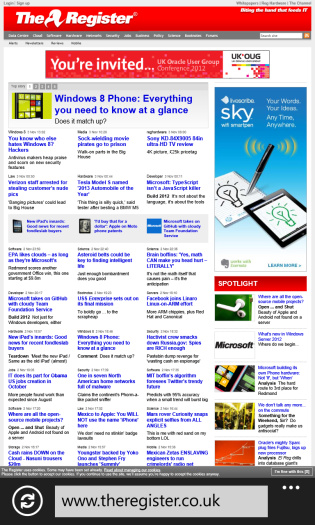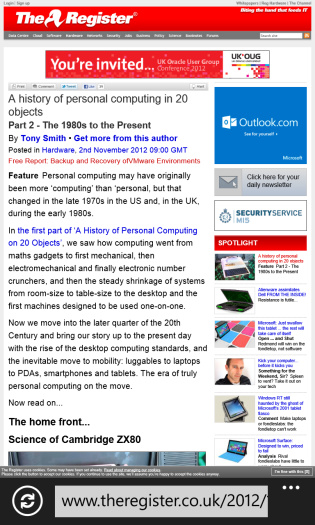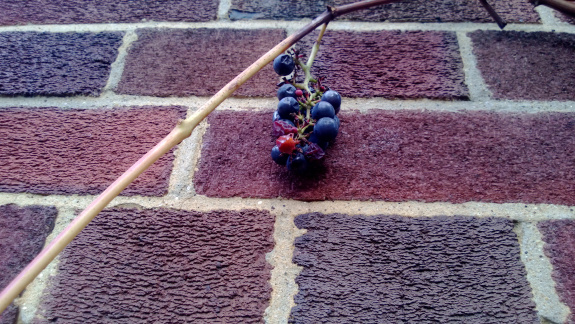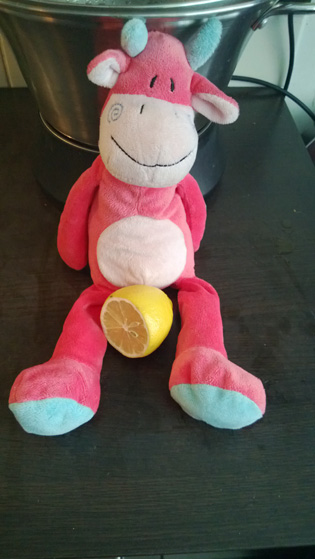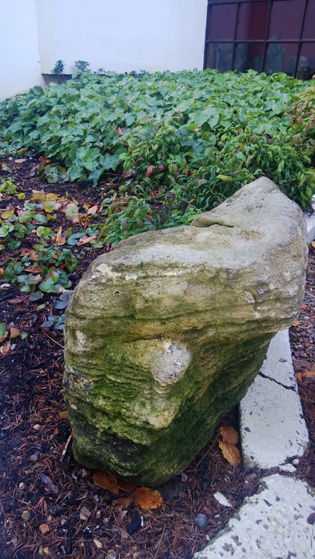Original URL: https://www.theregister.com/2012/11/08/review_nokia_lumia_920_windows_phone_8/
Nokia Lumia 920 Windows Phone 8 handset review
Microsoft's mobile OS refresh – is it more of the same?
Posted in Personal Tech, 8th November 2012 11:30 GMT
If you ever go down the pub and let slip you’re a tech writer, you’re invariably asked for recommendations. With smartphones, this is pretty difficult these days because they’re all pretty good. No, scrap that, today’s devices are just amazing compared to what you could get a few years ago. They all do a job; you can’t really recommend a ‘bad’ one. Manufacturers and fanbois engage in a furious War of Small Differences.
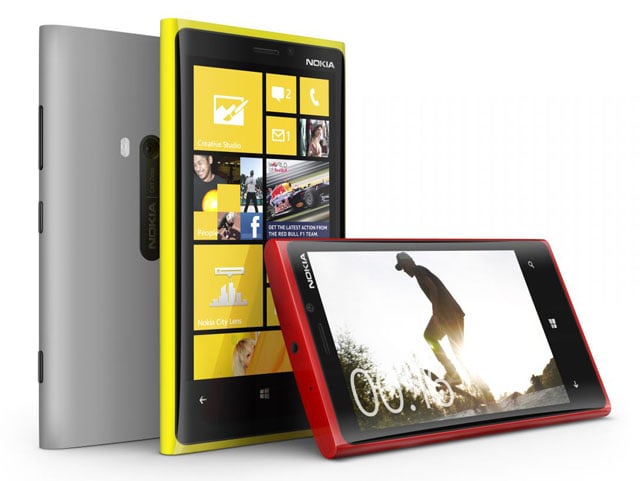
Nokia's Lumia 920: waving the flag for Windows Phone 8
With its new Lumia 920, Nokia has gone for ‘biggest and best’, with one zinging USP. This is a hefty but impressive flagship, and undoubtedly Nokia’s strongest all-round product in several years. In short, the Lumia 920 is a very strong contender for your money, once you can accept the device’s formidable size and mass.
I’ll start backwards, with a summary. The phone’s USP is the camera. Nokia's 808 PureView aside, arguably, this is the most impressive camera phone on the market, measured not in megapixels but in terms of practical everyday results. Here’s a great example of a product team working on things that give users a real world benefit; videos are smooth, and low light photography, without a flash, is quite outstanding. This phone should be worth considering for the camera unit alone. It’s that good. Nokia details its PureView tinkering on the Lumia 920 here [PDF].
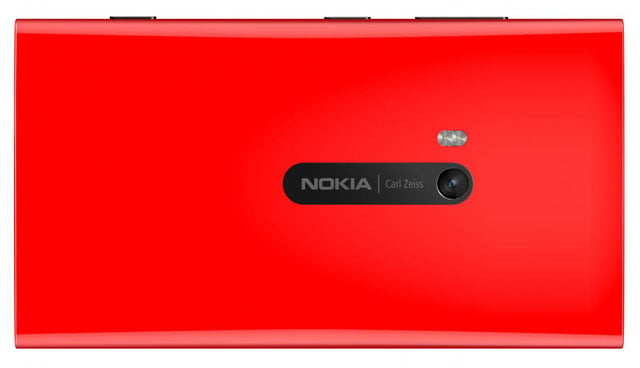
The camera isn't as high-spec as the Nokia 808 PureView, but it's still a great snapper
Windows Phone integrates basic social networking and messaging as well or better than any other device, getting you set up very quickly out of the box. The screen on this new phone is terrific – a 4.5inch IPS display 1280x768, although the WP design with Giant Text for buttons nullifies this somewhat. This is a phone that can even be used with gloves. And the whole things is built like a tank. The design resembles the Lumia 800 but bigger and boxier, although simplified: USB at the bottom, headphone jack at the top.
There are three other features that aren’t USPs to the new Lumias – or even this new Lumia – but are still great things to have. One is the blistering speed of the dual-antennae flavour of 3G, which this phone supports. DC-HSPA+ delivers such data so quickly, running on 3’s UK network, it was hard to distinguish a Wi-Fi connection from a cellular data connection.
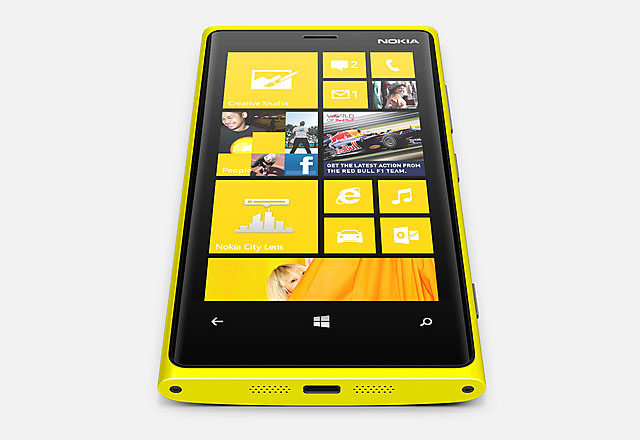
It's bigger than it looks here – a lot bigger
Sod 4G, I thought. This speed boost is really noticeable in the overhauled Windows Phone browser, IE10, which can render a Reg page in a flash, and most complicated newspaper front pages in three to five seconds. The page just seems to flow into place. Browsing looks good too on the screen. The second bonus is HD voice. Calls between the 920 and an iPhone 5 on the same network were terrific. We’re still experimenting with calls across networks, but the story is good so far.
Charge coupled device
The third bonus is wireless charging. This is a nice-to-have rather a “must-have”, and it doesn’t come cheap: a charging plate is £45, and the Fatboy Charging Pillow won’t leave you much change from £80. But once you have a wireless charger around, then using it becomes second nature, you top-up more often than you would. It’s one tiny hassle removed from the day.
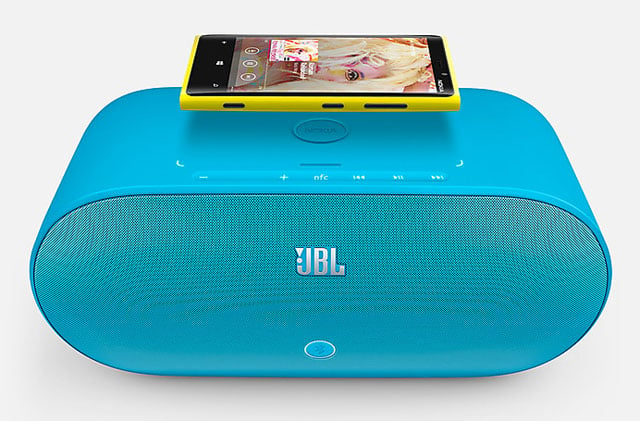
JBL's PowerUp Bluetooth speaker features NFC and wireless charging
The phone doesn’t need to be carefully aligned with the plate, so you just plunk it down and let it charge. Which it does fairly rapidly; there is a speed penalty to wireless charging but it’s surprisingly light: wireless power-ups are around 10 to 20 per cent slower than direct charging, I found.
On the Blackberry Bold 9900, which also supports wireless charging, the speed penalty is more in the range of a third to a half longer. Battery life is good: WP8 is more meagre with its power consumption than Android and there’s no 5pm panic – when you realise your smartphone’s power is so low it won’t make it through the evening, and you’re out and about.
Come to mention it – how did anyone get around a city before 2009? Perhaps there wasn’t any public transport back then. Perhaps it hadn’t been invented yet. Perhaps every town and city had 24-hour on-call Olympics style ambassadors standing around waiting to be asked ‘Is there a Caffè Nero near here?’ or ‘When does the last train to High Barnet leave?’ or ‘Here’s a funny picture of Graham Linehan’s slippers I’ve photocopied really badly. Take it!’. Or telling Jimmy Savile jokes.
The downside of the device is obvious: it’s big, it’s wide and it’s very heavy. The Lumia 920 tips the scales at 185g, or 6.5oz. Rivals are slimmer and lighter and substantially more comfortable to hold and carry – HTC has two very attractive rivals also running Windows 8. The smooth finish of the 920 also makes it slippier to grip – owners will probably want to invest in a non-slip case.
After a week with the Lumia 920, Apple’s iPhone 4/4S feels like a small smooth pebble, which it has never done in 18 months. “Is there actually a phone in there?”, I wondered.
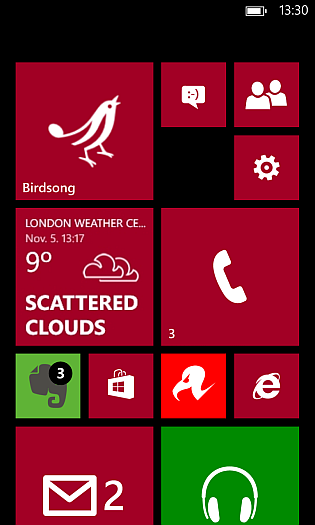
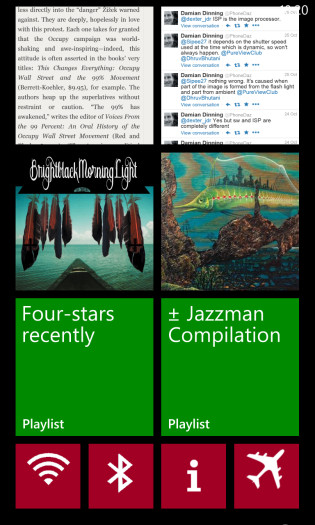
Web pages, playlists and albums pinned to the home screen
The other disappointment is that the user-facing bits of Windows Phone – the portions you interact with the most – are very much the same as a year ago. Microsoft has made the radical changes under the hood, but otherwise Windows Phone has has foregone a year of updates. The phone manufacturers needed a new OS for the Christmas selling season and Microsoft simply ran out of the time it would have devoted to tweaking the apps.
Unfinished business
For sure, WP8 and WP7.8 have a much nicer and more flexible home screen, allowing you different sized tiles. There’s tethering built-in to every Windows phone, and Nokia Maps, and a nice new sandbox area for children: Kids Corner, where they can play with kids apps and not access the internet, the app store or make phone calls. And your sprogs won’t lock or wipe your phone if they enter the passcode incorrectly repeatedly – which happens, believe me.
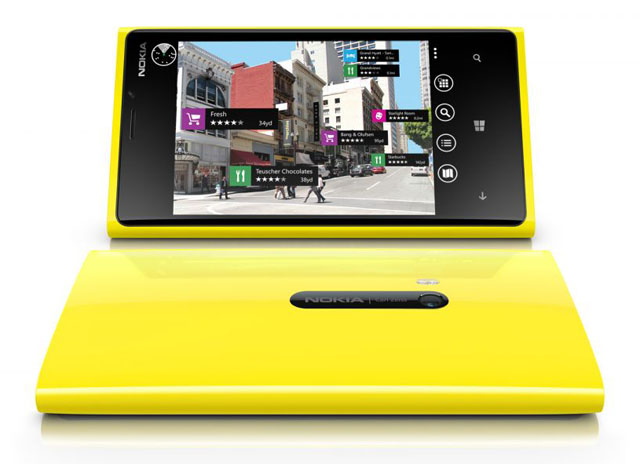
Don't be fooled, Nokia isn't prepping another Booklet
But in such a competitive market, where the rival platforms were already more mature, it is odd and disappointing to find so little improvement to the built-in apps. Every Windows Phone 7.x user (and there aren’t many) will have their own list of must-fixes – and most will be disappointed.
Music playback and the ringer still share the same volume setting – in practice this means missed calls, I found. We should, by now – and remember, this is version 3.0 of the platform – be able to flag email messages as important. Or Mark All as read, or (as per Blackberry) ‘Mark Prior Read’. We can’t favestar Tweets in the People hub. There’s no notification aggregator yet. Microsoft admitted it ran out of time on this one.
You can still be notified by Live Tiles, if the developer supports it, and the flashing ‘Toast’ notifications. And there are little flags on the lock screen, suggesting something has been received. But an aggregator is much missed. Even Apple swallowed its pride and added one to the iPhone, shamelessly pinching it from Android. Windows still won’t do bog-standard 3G video calls.
Desperately-needed usability tweaks are also missing. The Bing button can’t be reprogrammed – and frequently gets pressed by accident when the phone is in landscape mode for typing, throwing you into Bing. The buttons can’t be disabled during games either.
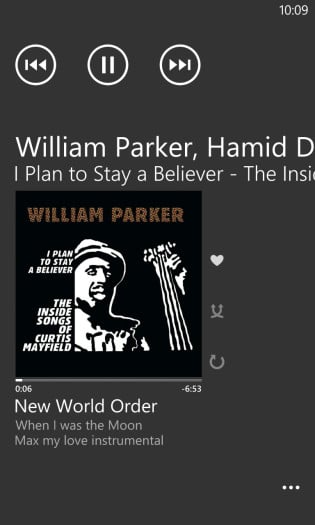

Music controls on the home screen - here playing a podcast
So your reviewer’s job is a lot easier – I can just refer you to the Lumia 800 a year ago. It’s quicker to say what’s new and what’s specifically unique to Nokia’s software bundle here.
Nokia’s extras
Nokia surrendered exclusivity on Nokia Maps to Microsoft, meaning all Windows Phone 8 devices, including those from Nokia’s rivals, can now bundle it. Nokia Maps is a superb vector-based package that works offline – it’s far and away the best mapping software that’s bundled with a phone today.
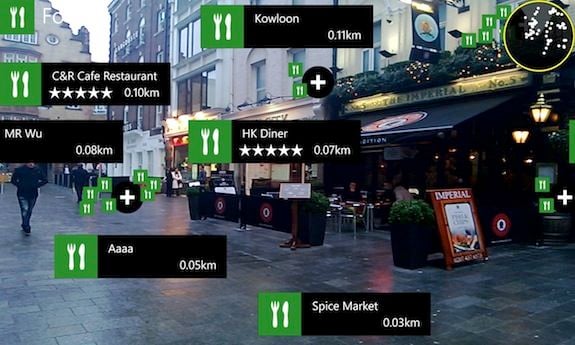
On this street in the West End are four adjacent food spots: three restaurants and a pub. CityLens failed to identify any of them, but highlighted restaurants that aren't visible (or even close by) instead.
What’s exclusive to the Lumias is Nokia Drive, giving turn-by-turn navigation, and other location- -based software. One of these is City Lens, an augmented reality overlay providing local information, which at first looks rather gimmicky. But it’s improving rapidly, and it doesn’t have to be used in the dorky point-and-peer camera mode.
Nokia Transport was one of the unexpected highlights of the Lumia 800 – nothing else gets you the bus or train time where you are quite as quickly or conveniently. It wasn’t bundled with my device, but I expect it will be available for a download imminently.
Nokia also has its own umbrella wrapper app around the music player, and Microsoft has another one, the Xbox app. Nokia’s wrapper leads you to a free, non-interactive curated music streaming service, which is better than it sounds. Indeed, I’m obliged to report that for their easy listening selection, French band Air chose The Velvet Underground’s Venus In Furs, and Heroin. Different strokes, I suppose. Microsoft’s Xbox wrapper leads you to Podcasts and its Zune store.
Either way, it’s the same music player underneath, and both wrapper apps rather get in the way. From the music player you can pin albums and playlists to the home screen. But if you click directly onto the playlist, you can’t navigate back into the music player – only back to the home screen, I discovered.
The photo viewer is much as it was before, but some of the integration is starting to pay off. You can ‘share’ not just to email accounts and social networks, but to registered apps such as WordPress, Evernote and the new ‘Rooms’ feature. The what, you ask?
Well, Rooms is one of the few new userland features to make it into WP8. It’s slightly daunting – you invite contacts to chat, view a shared calendar, and share notes and photos in a private area. Instant groupware – just like NetMeeting! The help documentation doesn’t explain what invitees will see – or whether they’ll be able to use it on a non-WP8 device. It’s all quite mysterious and a little unnerving. Fear of spamming your friends may put most people off experimenting. Incidentally, if you're on a data consumption conscious tariff, Nokia also includes Counters to keep tabs on usage.
The camera
Nokia has isolated the physical lens unit so it ‘floats’ on stabilisers, and gyroscope sensors detect movement. The physical dampening helps but software also keeps tabs on any camera shake to improve the responsiveness of the compensations. Additional digital post-processing software also reduces the jitter. Some rival smartphones employ some digital processing, but none have the optical stabilisation (OIS) which, while common in dedicated cameras and camcorders, appears unique to this model.
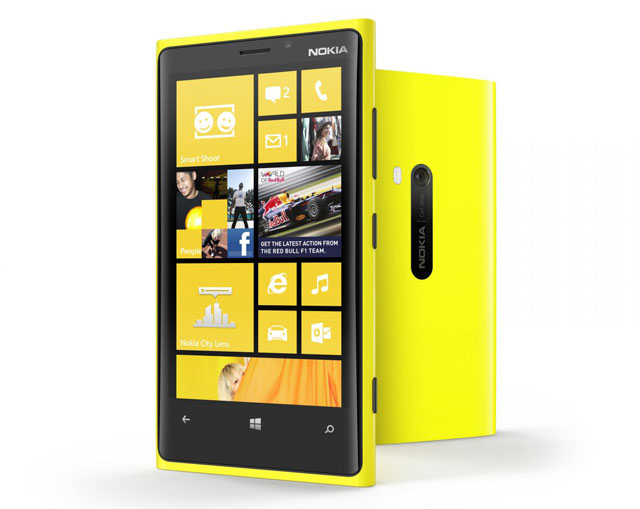
Carl Zeiss f/2.0 lens with optical image stabilisation, rather than relying entirely on digital processing
The result is terrific still photos and movies. Nokia got some grief from bedroom bloggers for ‘faking’ the first demo of this – but the results are so good it didn’t need to. The bright f/2.0 aperture lens is ideal in low light conditions and, combined with OIS, is forgiving during long exposures too. Around 8x longer than rivals. While the 920 takes consistently good pictures, it really revels in the low light, capturing an image with minimal noise artifacts nor gloomy washed out colours.
The spec on the tin says it’s 8.7Mp – and phones are sold on megapixels, so it doesn’t sound all that dramatic. But the results have to be seen to be believed. There’s more to it than the stabilisation, too. Flash shots at close range are typically horribly over-exposed, but consistently excellent here. And the LED flash has a new ‘pulse’ mode.
Just don't expect the pixel binning on Nokia's 808 41Mp model to make an appearance here. PureView has now become a generic term for Nokia's new phonecams and the Lumias don't get the same sensor tech. Still, Microsoft brings some photo features of its own in WP8 with Lenses, giving real-time as-you-shoot effects. More will follow, but one bundled here is from Nokia itself, a novelty ‘GIF-animator’, which allows you to animate portions of a still capture.
Nokia’s Group Shot app has been updated. This allows you to take a group photograph and airbrush out, Soviet style, ideologically impure Party members, or dumped lovers, who you no longer wish to see. Rather more useful is the excellent Smart Shoot – which takes several group shots and pick the best individual headshots from each one for a composite. Microsoft demonstrated many more lenses recently, so there will be a novelty for every occasion.
Overall though it’s the remarkable camera – one that gets real world results without faffing with settings – that’s the attraction of this phone.
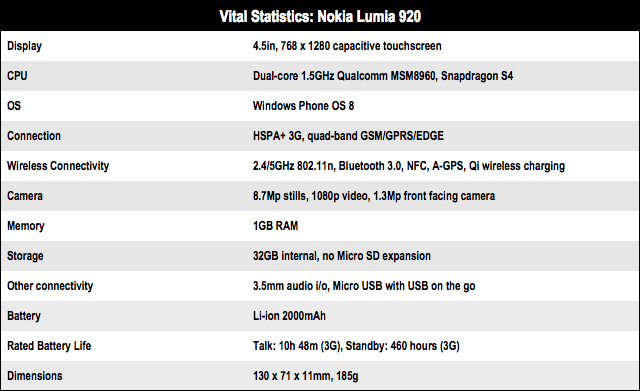
Sample Shots

At dusk: OIS won't cure all ills as unsteady shooting with this 1/20sec image shows
Click for a full-resolution image

Lumia 920 image crop at 100% retains detail and colour – 1/15sec, f/2.0, ISO 640

Apple iPhone 4S (HDR on) image crop at 100% reveals significant noise artefacts – 1/15sec, f/2.4, ISO 800
Here's the low light comparison. All three pictures were taken a minute apart. The first two are the Blackberry Bold 9900 – not the best camera on the market, but not the worst – and fairly typical of the optics people have in their pocket. The bottom picture was taken on the Lumia 920.

Blackberry Bold 9900: 'Night mode' [90% JPG compression]
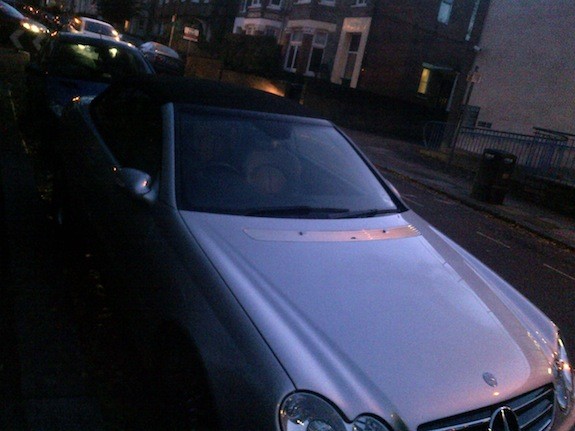
Blackberry Bold 9900: 'Night mode', Flash:off [90% JPG compression]
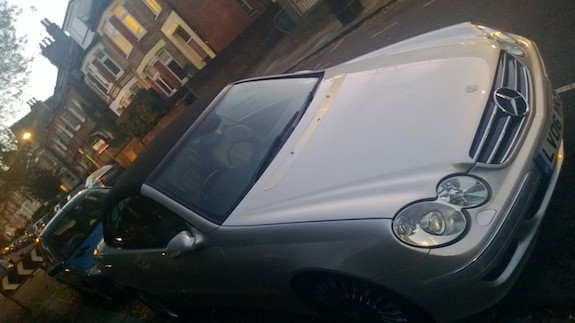
Nokia Lumia 920 Night Mode
Here's some video, including standing still, panning, and walking.
Video originally captured at 1080p
Odds and sods
Even though the Lumia 920 has no micro SD slot, it does at least come with a generous 32GB, which is just as well if you're likely to be shooting a lot of HD video. Also, Microsoft is bundling 7GB of cloud storage here and SkyDrive is steadily improving. One outstanding feature is the ability to capture work in progress on other machines, down to a snapshot level. This is more promise than reality right now, but it’s a strong reason for having a look at Windows Phone.
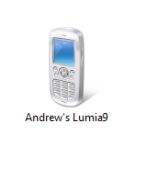
Do they still make phones like this?
Windows 7 mates with new Windows Phone
The story with PC and Mac connectivity continues to be a mixed one. There’s a Windows 8 Metro app – which is not much use if you’re on Windows 7. Zune has been deprecated but the device still syncs music with Windows 7’s Media Player and appears as a browseable device in Windows 7 Device Centre.
On the Mac, the Windows 7 Phone Connector has been rebranded the Windows Phone app, but it’s currently a catastrophe. At first I got two successful syncs with my MacBook Pro running Lion 10.8.2, but then a dozen subsequent crashes, each inviting me to send a bug report. It just doesn’t work.
And WP’s contacts management is as opaque as ever – you can only sync with a Live/Hotmail account, although Nokia appears to be working on bringing its PC Suite into the modern era. Here’s hoping it can make contacts manageable again.
As for app compatibility, the story is mostly good. There’s no Skype – there’s an all-new version with a new UI and multitasking imminent. And the Amazon Kindle app only works once. It appears to be fine, but won’t start once it’s been ‘tombstoned’. I found third-party apps that took ages to restore from their tombstoned state are working in two or three seconds.
There’s still a few too many splash screens in the user experience, though, and given the speed of the phone the animations are beginning to be unnecessary and tiresome. Yet for all that, you’ll have a hard time telling a WP7.8 device and a WP8 device apart. Windows Phone now has much improved multi-tasking and better driver support but without the performance or power consumption penalties we’d feared.
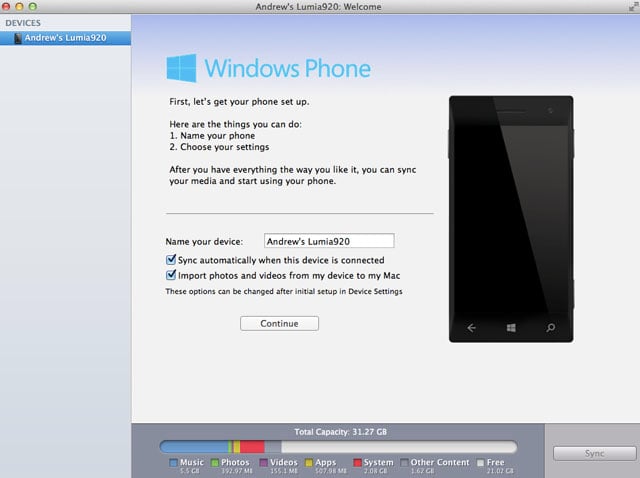
Your mileage may vary but you'll be lucky to get beyond this screen with the Windows Phone 3.0 sync app on a Mac
Indeed, Microsoft has done a magnificent job of making an epic overhaul of the Windows Phone plumbing work smoothly. The three pieces of bedrock on which WP7.x was based have been completely replaced in WP8. The CE kernel has been replaced with the NT kernel, out goes the Compact .NET framework and Silverlight/XNA are deprecated, but retained for compatibility. Native code is in, which means you can write in C#, in C++ for games, and the system gains DirectX support. In fact it now supports a ton of useful middleware frameworks.
Sound or vision?
In practical terms, the Lumia 920 offers the best cameraphone by miles. Good battery life, a great screen and zippy performance make up the key attractions. All this comes at a cost however, and the main one is the slab-like weight and ungainly finish. I got used to it pretty quickly. There are people who buy Volvos simply because they're built like tanks and to hell with the looks. But it might be a deterrent to anyone not drawn to the camera.
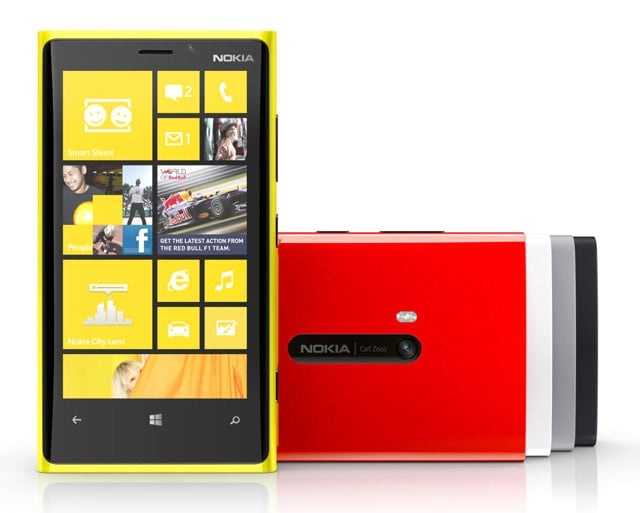
Design matters: forget the colours, what about the shape?
One surprise nobody expected two months ago is that Nokia’s designers have been comprehensively out-thought and outplayed by HTC. HTC is offering smaller Windows 8 phones (the 8s and 8x) which look and feel better, are really tactile, and even have richer and more subtle colours. HTC’s models might induce that “5pm panic”, on account of their smaller batteries; the Lumia 920 won’t. But they perform most things just as well, focusing on music rather than imaging.
What a pity so much good work has gone into these Lumias – particularly the 920's camera – that may go un-noticed because the design is so utilitarian and boxy. Nokia is making much better products than it did before the Windows alliance, and it’s getting R&D out of the labs into products quicker. However, design is now the weakest link. Still, if you’re tempted to have a look at a Lumia 920 then your carrier options will be limited. It’s only available in the UK through the EE family of brands: EE 4G, T-Mobile and Orange, through its stores of Phones4U. The exclusivity period lasts until the end of the year.
Inexplicably, there will be no unlocked version available for enthusiasts for this lock-up period. And Nokia said it may consider the exclusivity into the New Year, although no decision has been taken. I very much hope not. Unlocked models exist – an unlocked Lumia 920 is what I reviewed. Nokia’s other WP8 model, the Lumia 820, has its attractions too – removable battery, more friendly rounded corners, and it can support wireless charging through a slip-on case – but it features the old 800 x 480 screen resolution and doesn’t have the showstopper PureView OIS camera.
One aspect that is likely to disappoint punters is that they’re getting last year’s software, in most cases, albeit on a better infrastructure. Microsoft has done much of the the hard work in transitioning to the new kernel, and needs to announce and deliver updated apps sometime soon – by the end of Q2 next year.
Verdict
Evidently, with the Lumia 920, Nokia can once again deliver a phone handset with a game-changing and useful new technology feature. But relying on a platform partner means marching to its tune - and Microsoft has improved the bedrock of its Phone OS stronger without improving userland as it should have. Ultimately, the choice comes down to whether the camera benefits are worth the weight. And if you want network freedom, you're going to have to wait. ®
More Handset Reviews |
||||
 Sony Sony
Xperia T |
 LG Vu LG Vu |
 A History of the A History of the
Smartphone |
 Samsung Samsung
Galaxy Note 2 |
 Apple Apple
iPhone 5 |
